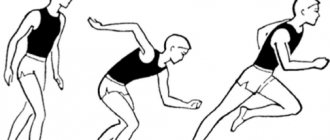Running 3 km is an excellent exercise that allows you to always maintain ideal physical shape. At the same time, it is very difficult to run such a distance well without appropriate preparation. You will need to spend at least a few weeks developing endurance and significantly improving your existing physical performance.
But what if you don’t have this time, if you need to run and show good results right here and now? Military personnel called up for military service very often encounter a similar problem, since running 3 km is included in the list of standards that allow one to evaluate the physical characteristics of future defenders of the Motherland. We will try to help you solve it, and also tell you how to run this distance as quickly as possible without serious consequences for your body.
Minimal preparation to help you easily cover a distance of 3 kilometers
The first tip to help you get fit enough to complete a 3K run without problems is to start training for your run early. We are sure that not everyone will listen to him, but we will definitely tell you how to adapt your body to increased physical activity. This is in your interests - if you know about the draft, you should be prepared to pass the sports standards. Preliminary preparation will allow you not to lose face in front of your future colleagues and not become an object of their ridicule in the coming months.
How to prepare for running standards? Just follow the recommendations below:
- Do a warm-up run every day for 10-15 minutes. After just a few days of such simple and short exercises, you will see that your body copes with the load much easier, and your breathing returns to normal;
- Try running your usual distance with special weights. This will significantly increase endurance and improve physical fitness. In addition, running speed will increase significantly;
- Do exercises to develop your calf muscles, hamstrings and quadriceps. Muscle mass will significantly increase your running speed, and will also increase endurance at distances such as 3 or 5 km.
Is it possible to cope well with the 3 km running standard without such preliminary preparation? Yes, you can. But for this you will need, firstly, to make significant efforts, and secondly, to follow our recommendations.
A set of stretching exercises
It helps make the muscles and ligaments of the legs, hips and buttocks more elastic. Do it after every workout. “Fix all positions for 30-40 seconds ,” comments Ksenia Sharifulina.
Stretching the front of the thigh
Stand straight (can be against a wall or any other support), feet hip-width apart. Bend your right leg and pull your heel towards your buttock, holding it in this position with your right hand. If necessary, hold onto the support with your left hand. Pull your knee down, point your pelvic bones forward. Stay in this position for 30-40 seconds , feeling the stretching of the muscles, and repeat the same on the other side.
Hamstring stretching
Stand straight, feet hip-width apart. Bend your right knee and place your right shin on your left thigh. Bend your left knee slightly, lean your body forward and reach your hands towards the floor. Feel the stretch in the back of your right thigh. Hold the position for 30-40 seconds and repeat the same in the other direction.
Stretching the calf muscle
Stand straight, feet hip-width apart. Step your right foot forward, pull the toe of your foot towards you and rest on your heel. Lean your body forward, rest your hands on your hips. Lock in this position for 30-40 seconds , then repeat the same in the other direction.
Stretching the front and back of the thigh
Stand straight, feet hip-width apart. Step your right foot forward and lower into a lunge, placing your hands on the floor on either side of your right foot. Leaning on your right foot, palms and toe of your left foot, lightly “spring” your body and pelvis up and down. Do this for 30-40 seconds , then repeat the same on the other side.
Stretching the gluteal muscles
Stand straight, feet hip-width apart. Bend your right knee and pull your right thigh toward your stomach, clasping your shin with both hands. Watch for a feeling of stretch in your right thigh and buttock. Stay in this position for 30-40 seconds , then repeat the same in the other direction.
We run 3 kilometers without preparation
If you didn’t play sports after school, and also ignored all the tips listed above for preparing for the standards, then passing them will be much more difficult. Running 3 km takes a lot of energy and requires endurance. Therefore, we will give some useful recommendations that will help you cope with such a difficult task:
- Be sure to warm up immediately before going on the treadmill. Just a few simple exercises performed at a fast pace will warm up your muscles and allow you to cope even with heavy physical activity;
- Don't dress too warmly. While running, you will heat up in any case, but fairly heavy winter clothing can significantly increase the load;
- It is best to start the distance approximately 40-60 minutes after eating. Otherwise, you will feel serious discomfort and will not be able to even out your breathing;
- hurry up slowly. At a distance of three kilometers, you shouldn’t immediately waste your energy trying to take the lead. Start the distance with an easy and calm run, do not rush anywhere, so as not to immediately lose your breath. Using this approach, you will be able to save maximum energy by the end of the second kilometer and speed up significantly;
- breathe correctly. Ideally, for each step there should be one short inhalation and an equally short exhalation. When you pick up speed, it is better to exhale as sharply as possible - then the lungs will draw in air themselves, making the task as easy as possible for you;
- To minimize the negative impact on the body that can result from lack of habit, do not stop immediately after completing the distance. Run another 300-400 metro, gradually slowing down the pace and restoring your breathing.
Even if you haven’t exercised for a long time, all these recommendations will allow you to overcome a three-kilometer distance with minimal discomfort and give you the opportunity to show completely normal results.
Many athletes strive to meet the GTO standard, and more specifically, to run three kilometers in twelve minutes. Both experienced athletes and beginners have a desire to fulfill such standards, however, as a rule, only trained athletes can achieve such a result.
In order to show such an excellent result, it is necessary to conduct regular running training, eat right, lose excess weight, strengthen the body, and give up bad habits.
Runners who set themselves the goal of running three kilometers in 12 minutes need to actively train and develop:
- speed,
- oxygen use efficiency,
- aerobic strength.
General recommendations
Losing excess weight
Often people usually think that with the help of running exercises the extra pounds will “melt off”. Of course this is true. But you also need to remember that excess weight can create a very large load on the body, primarily on the joints and the cardiovascular system.
Therefore, before starting active training and preparing for passing standards or serious competitions, you need to try to get rid of fat deposits as much as possible. First of all, following a proper diet, working out in the gym, and walking will help you with this.
Strengthening the cardiovascular system
A runner must strengthen his heart, because without a strong heart you cannot build endurance. You can strengthen your cardiovascular system, for example, through cardio training.
Among other things, they will help you understand how best to use your own strength and how to learn to run three kilometers in a short time.
Exercises on various machines are suitable for such cardio training:
If you are not a big fan of the gym, then exercise equipment can be replaced by walking, cycling, skiing, boating, or kayaking.
Swimming will also provide excellent results in terms of strengthening the cardiovascular system. In general, you need to move as much as possible and lead an active lifestyle.
Correct breathing
Running can only be effective if you have the correct breathing technique. Sometimes it allows you to simply complete the distance, not to mention achieving high results.
How to eat properly?
It is extremely important to take care of your diet. Before training, you need to “feed” the body with proteins and carbohydrates in a ratio of 1 to 3. Also, before jogging, you should give up fiber and fat to avoid stomach problems.
Here are nutrition tips:
- Two hours before your run, you can have a snack of fruit and a couple of peanut butter sandwiches.
- An hour before training, you can drink a glass of orange juice plus something light that contains protein.
- If there are a few minutes left before your workout, eat a handful of nuts, dates - they contain glucose,
After training, within 30 minutes you should eat food containing proteins and carbohydrates in the following proportion: 1 to 4 or 5. You can also eat carbohydrates.
Getting rid of bad habits
It is highly recommended to quit smoking. This bad habit is incompatible with running. Only by getting rid of this bad habit can one claim to achieve certain results in sports, in this case, covering a three-kilometer distance in a certain period of time.
Endurance development
There are several effective exercises for developing endurance:
- Running in conditions of slight elevation, approximately 5-8 degrees. You should take up to thirty steps within twenty seconds. You should run uphill for at least twenty minutes.
- You can alternate running on flat terrain with running uphill. For example, 40 minutes on a flat path and 20 minutes uphill.
Tips for running three kilometers
Here are the following rules and tips for training to overcome a three-kilometer distance:
- You need to start by running short distances at a calm rhythm.
- Training should be done at a convenient time, it doesn’t matter - in the morning or in the evening.
- You can't be lazy and skip workouts.
- It’s better to run with a player, downloading your favorite music into it.
- Pay special attention to choosing high-quality running clothes and shoes.
Training program for running three kilometers
Below are sample training programs for different categories of athletes - from beginners to experienced and well-prepared runners. Remember that before training, a good warm-up is necessary, and after running, a cool-down and stretching is a must.
Three kilometers in 15 minutes (for beginners)
At this stage, running training should be carried out at least three times a week, and at each of them cover a distance of three kilometers.
This program takes basic running skills to perfection. At the end of this phase of the training process, the three-kilometer distance should be covered in fifteen minutes.
Here is an approximate plan for weekly training (in total, there should be from six to ten such weeks at this phase of the training process:
- First day: running a distance of five kilometers at speed.
- Day two: running a distance of one kilometer in a minimum of time. We do three approaches, with a one-minute rest between them.
- Third day: running a distance of five kilometers at speed.
Three kilometers in 13 minutes (intermediate level)
At this stage of the training program, classes become of better quality, to develop greater endurance. The distance also increases.
- First day: running a distance of seven kilometers at speed
- Second day: we run one kilometer in a minimum of time. We do three approaches, resting for one minute between them.
- Third day: we run half a kilometer in a minimum of time. We do eight repetitions, between which we walk quickly for a minute as a rest.
Three kilometers in 12 minutes (advanced level)
During this phase of the training process, the number of days for jogging increases to four, the number of kilometers covered remains the same.
Many call this stage the most difficult. Interval training takes place here, that is, alternating intervals of high and low intensity physical activity. For example, running is replaced by squats, then running again.
Here is a sample training plan:
- First day: running at a distance of seven kilometers at speed.
- Second day: runs one kilometer at speed. I do four approaches, with a 40-second rest between each set.
- Third day: we run half a kilometer in a minimum of time. Thus, we do six repetitions with a 40-second rest between them (by rest we mean brisk walking).
- Day four: we run a distance of one kilometer in a minimum of time. We do three repetitions, between which we squat 30 times.
Three kilometers in 11 minutes (pro)
So, your goal - three kilometers in 12 minutes - has been achieved. It's time to move on and reduce the time it takes to cover this distance by another minute.
At this stage of the training process, which will stretch over five days, the burpee exercise is involved, which will help you further develop endurance. The technique for performing this exercise is as follows:
Squat down, place your palms on the floor in front of you, jump with your legs back so that your body is in the same position as during push-ups. Then we perform push-ups without pushing up from the floor, after which we return to the previous squat position. We do repetitions.
Particular attention should also be paid to recovery after running.
So, a sample training plan:
- First day: running a distance of five kilometers at speed. After that, without stopping, we do burpees fifty times.
- Second day: we run one kilometer in a minimum of time. We perform three repetitions, between which we do forty squats.
- Day three: we run 400 meters, after which we do burpees 10 times. We repeat eight times. In this case, a minimum of time should be spent on performing the exercises.
- Day four: we run half a kilometer in a minimum of time. We do six repetitions, between each of them – 40 seconds of fast walking.
- Day five: run one kilometer in a minimum of time. We do three repetitions, between which we walk quickly for forty seconds.
A few years ago I ran 3 km in no faster than 16 minutes. Pumping yourself up to a level like 3 kilometers in 12 minutes is an excellent result. Moreover, I am essentially not a runner at all, or rather not even a runner at all. Even so. I hate running!
PHASE III[edit | edit code]
Typically, Phase III is the hardest phase of any training program. The first phases have prepared your body for this work, and by this stage you should already be in shape to compete in some competitions that will help determine your current VDOT.
Some schoolchildren who run are forced to participate in two competitions a week - on Tuesday-Wednesday and on Saturday. If the competition is on Tuesday, consider Tuesday and Wednesday as two quality days of the week, supplementing the Tuesday competition with light interval training. Of course, if a competition is scheduled, the Tuesday training session must be adjusted to accommodate this or canceled and the Wednesday session proceeds as planned. When the competition is on a Wednesday, use a quality Monday-Wednesday training schedule, supplementing the Wednesday competition with light interval training if necessary. If there is no midweek competition, use Monday and Wednesday as two quality days of the week. As discussed in the previous chapter on training for the 800m, I like to schedule two quality days per week that you can spread out to suit your needs.
Saturdays are reserved for solid quality sessions, which can be held in the form of competitions. If you have a race scheduled for Saturday, you can follow it up with a shortened version of a quality post-race session. At the very least, you can run a few 200-meter segments as a cool-down. If you are not competing during this phase, simply follow your training schedule. The total mileage of Phase III should not increase. The proposed exercises themselves are quite demanding, so you should not add excessive load.
From theory to practice
Picture 1 (screenshot from the Endomondo running program) shows all the personal records (personal records) for running at various distances, including 3 km. This program has an error, but even with these shortcomings I can manage 12 minutes for 3 km. We won't talk about it now.
Also, in addition to the above, I have the VII degree gold badge for protecting the GTO standards, where one of the standards is to run 3 km in 12 minutes.
Based on this, I believe that I have the right to write a post about how to run 3 km in 12 minutes without further ado about working in pulse zones, about creatine, glycogen, breakdown, oxygen absorption, etc.
Each case and each 3 km running program is unique in its own way. Therefore, I will describe all my parameters so that you can understand under what conditions and actual indicators it was possible to achieve this time.
What we have
Age at the time of writing this article is 32 years old, weight 73 kg with a height of 172 cm. I regularly engage in strength sports and 3 years ago I could barely run 3 km in 16 minutes. In the previous year, the total running volume was more than 500 km. If you are a runner, you understand that this is not much, but for the average person, it is more than enough. I am describing all this so that it is clear at what level I started training and what kind of life I lead.
I described earlier how I started and what I did to improve my results in the 3 km run. But during the practice I changed my opinion a little on several issues and most likely I will change my opinion more than once when I receive more information and practice. Still, I recommend reading this article so that you understand the dynamics of both thinking and development.
Drugs that increase endurance
To become more resilient, athletes can take special medications. They have different effects, therefore they are classified into the following types:
- secondary impact;
- combined action;
- metabolic;
- debilitating.
A clear understanding of the specific properties of each allows you to make a choice in favor of a specific medication.
Depleting
This group of medications includes drugs such as mesocarb, caffeine and pyridrop. They stimulate the body's hidden energy reserves, which increases the runner's endurance. These biological products provide a significant increase in physical indicators. The downside is that they have undesirable consequences, including an increase in the recovery period.
Metabolic
They are represented by substrates that are energy suppliers, actoprotectors, non-steroidal anabolics, nootropics, and steroids. The advantage of metabolic means is that they do not deplete internal energy reserves, but, on the contrary, provide it for a longer run. This group of drugs has no specific contraindications, so you need to independently monitor your well-being after the first and second doses.
Combined action
Mixed principle drugs stimulate gluconeogenesis in the liver, resulting in the formation of glucose. Dexamethasone belongs to this group of drugs. This drug reduces the rate of amino acid transport, that is, it has an anti-anabolic effect. Unlike previous drugs, they can cause significant side effects, reducing the body's protective functions, causing muscular dystrophy.
Secondary action
Increasing endurance through this category of drugs occurs by studying the factors that affect fatigue. When the main individual characteristics of the athlete’s body are identified, they begin to use a drug with a secondary positive effect.
Issue #1 - TOP 5 Supplements for Endurance
Cardiovascular system and breathing when running
There are no pathologies, I don’t smoke, the training load system is gradual. After reading articles from other sources, it turned out that smokers can forget about this standard. I can’t agree with this, there are unique people, but still I was very lucky in this regard. But I’ll also note that I smoked 12 years ago.
As for breathing, you can often find a breathing technique when running 3 km - inhale for two steps and exhale for two steps. I used this technique all the time. During such breathing, in my case, the bullets immediately became more frequent. In turn, you won’t run far at a high heart rate.
Running with an opponent superior to you
Running with an opponent is the best thing ever. If you have such a friend, you are lucky. I had a friend like this. For the first time, halfway through the 3 km distance, I was blown away. His superiority over me was significant. That's the whole point. The spirit of competition, the will to win, forces a weak body to develop precisely at such moments.
No runners you know...? At the stadium there is an opportunity to ask someone to go for a run together. Don’t choose to be weaker than yourself, it will only make you worse. The only one stopping you from achieving results is yourself. Train your will.
Result: Improved endurance and speed by an average of 40-60 seconds.
ATTENTION: If you have a coach, you don’t have to read this article.
A little personal history
One day I was preparing for a running competition at a stadium in the city where I live. A magnificent place on the Black Sea coast. And I was lucky enough to run with someone who changed the way I thought about breathing while running. I often try to look closely at people who are stronger and faster than me. Monitor their technique, breathing and exercises. And he told a simple philosophy of breathing. You need to breathe evenly and not as often as I did. At the same time, deeply smell the sea, listen to the wind, listen to the cries of seagulls and try to relax. Something like meditation, only in motion.
Of course, I tried to breathe like this and did not immediately understand all the subtleties. Practicing all the time, it dawned on me! You need to breathe deeply and in such a way, as if after a nervous situation or conversation you are trying to calm down, inhaling deeply and exhaling smoothly. Breaaaaaaaaaaaaaaaaaaaaaaaaaaand! This way I manage to lower my heart rate (pulse).
How long does it take to develop the habit of running for a long time?
Everyone has their own pace of adaptation to stress, but usually 4-6 months of regular training is enough for running to become an integral and familiar part of life. The problem is different: how not to quit after a couple of weeks or months? The ultramarathoner notes that the easiest way is to run in a group - not necessarily in a running club, a virtual community is enough. Understanding that your brothers in mind are running somewhere motivates you not to give up training.
Alexander:
Our running club ERA has a joke about the three stages of a runner. The first is when a person starts eating special gels instead of bananas while running. The second is when he lacks the running app on his phone and buys himself a special watch with a GPS sensor. And the third is when he changes his name on Instagram from vasya_Ivanov to ultrarunner_Vasya. We know of cases where this journey took only a year.
Photo: unsplash.com/@hocza
Technique for running 3 km “from toe to heel”.
Going back a little, I described the technique by which I ran “heel to toe.” Then, after reading articles on the Internet, I began to retrain myself to run from my toes, because... this way I will run faster. As a result, I bought the book “Running according to the 80/20 rule. Train slower to compete faster,” which basically says that technique is not that important for those who like to run, be it toe-to-toe or heel-to-toe. I settled on the “toe to heel” technique only because it looks more impressive from the outside.
This once again confirms that you don’t need to get so hung up on the intricacies of running. Especially if you are not going to become an Olympic champion. Knowledge is power, but knowledge without practice is just another article on the Internet or a magazine that describes the breakdown of amino acids in the body and still does not answer the question: “How to run 3 km in 12 minutes.” What the hell are amino acids here?! Not up to them.
Where to train
It all depends on the conditions you have. Amateur races are held mainly on the highway, so it is most logical to train in a park where there is asphalt. Training on the stadium track requires special shoes - spikes.
For runners whose ligamentous apparatus is not yet very well developed, experts recommend running on soft ground. In the training process when preparing for distances of 3-5 km, it is also necessary to include hills and intervals or cross-fartlek.
Running program - 3 km in 12 minutes
One of the rules is consistency. Just start running regularly. Running is not a strength exercise, where sometimes a short break gives positive dynamics. I stopped running a little and added one minute to the time.
Day 1 – 5-10 km at an easy pace;
Day 2 – 2 km fast, 2 minute pause x 3 times;
4th day – 12 minutes quickly;
Day 5 – 7-10 km at an easy pace;
Days 3,6 and 7 – rest or active recreation.
If we take into account that strength training is still my main sport, then while gaining strength, I train in the gym all the days, if I just keep in shape, then strength training twice a week, where at the beginning of training 2 km at a competitive pace and one day of easy running.
Like that:
| More running | More strength | I support | |
| Monday | Run | Power | |
| Tuesday | Run | Power | Strength, Running |
| Wednesday | |||
| Thursday | Run | Power | Strength, Running |
| Friday | Run | Power | |
| Saturday | Power | ||
| Sunday | Power | Run | Strength, Running |
Let's sum it up
If you really want to run 3 km in 12 minutes and you understand why you need it, then it will inevitably happen. What I realized for myself is that I need to make more mistakes. Try, try and try again. If you just read articles on the Internet, nothing will happen. Many things cannot be taught, but they can be learned.
Practice running and create yourself!
Subscribe to blog news!
If you liked the article, then subscribe to blog updates right now!











